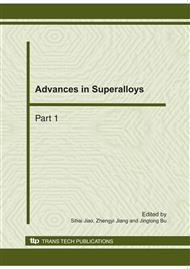p.1198
p.1202
p.1206
p.1211
p.1216
p.1222
p.1227
p.1233
p.1238
Effects and Mechanisms of Vanadium on Structural Transformation of BVRE Heavy Rail Steel
Abstract:
The different dilatometric curves of continuous cooling transformation with the different cooling rates were determined by means of Gleeble-2000 thermal simulation machine. The CCT curve of BVRE heavy rail steel was obtained by measuring the dilatometric curves and metallographic analysis. And the effects and mechanisms of vanadium on the phase transformation and microstructure of BVRE heavy rail steel were investigated. It is found that, the BVRE heavy rail steel only takes place pearlite and martensite transformation during continuous cooling. The CCT curve of BVRE heavy rail steel is moved to lower right with increasing vanadium content, which indicates that vanadium can obviously improve the stability of super cooled austenite and delay the pearlite transformation. When the content of vanadium is increased from 0.052% to 0.12%, the shortest incubation time of pearlite transformation is increased from 30s to 59s. When the cooling rate ≤ 5 ·s-1, with increasing vanadium content, both starting and finishing temperatures of pearlite transformation are decreased at different extent, meanwhile the pearlite is refined and the pearlite percentage is notably decreased. When the cooling rate is 2 ·s-1, the pearlite percentage is decreased from 65.7% to 35.9% with increasing vanadium content. When the content of vanadium is increased from 0.052% to 0.12%, the critical cooling rate of quenching is decreased from 13 ·s-1 to 7 ·s-1, thus the hardenability of BVRE heavy rail steel is improved.
Info:
Periodical:
Pages:
1216-1221
Citation:
Online since:
October 2010
Authors:
Keywords:
Price:
Сopyright:
© 2011 Trans Tech Publications Ltd. All Rights Reserved
Share:
Citation:


